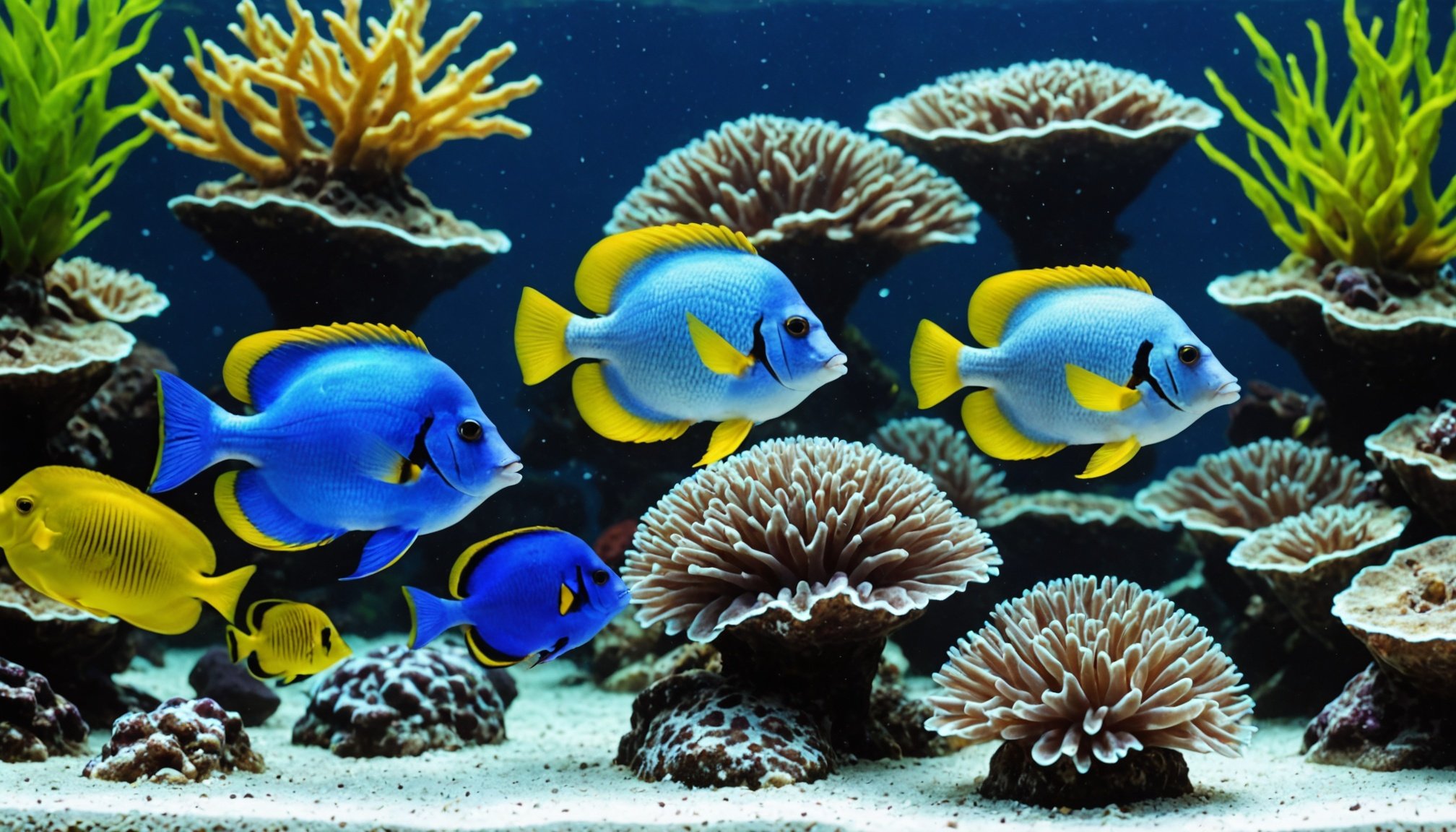Understanding Marine Aquariums
Marine aquariums are fascinating ecosystems that mimic the ocean’s environment, and they demand a unique set of attributes. A successful marine aquarium setup is reliant on several key components. Firstly, choosing the right tank size is crucial; it should accommodate the species you select while allowing room for growth and movement. Adequate lighting and heating systems are essential to mimic the natural habitat and ensure optimal living conditions for marine life. Filtration systems play a vital role in maintaining water quality and circulation, thus supporting marine fish care by providing a stable environment.
Marine aquarium basics include understanding the challenges beginners often encounter. One common issue is maintaining water parameters such as salinity, pH, and temperature. These factors are crucial for the health of marine life, making it essential for hobbyists to regularly monitor and adjust them as needed. Also, introducing new fish into the aquarium can lead to stress and disease if not managed properly.
Also to discover : Effective Tips to Soothe Your Dog’s Nerves: Reducing Anxiety During Car Rides
Beginners may find difficulty in balancing the ecosystem, especially in managing the compatibility of different species. However, with adequate research, planning, and commitment to proper marine fish care, these common hurdles can be overcome, ensuring a thriving aquatic environment.
Best Fish Species for New Enthusiasts
Choosing the right fish species is crucial for a successful beginner-friendly marine fish experience. Opting for easy care fish and those that naturally adapt to aquarium life will enhance their survival and overall health. A splendid place to start includes hardy specimens like clownfish, damselfish, and gobies, known for their robust nature and adaptability.
Have you seen this : Effective Tips to Soothe Your Dog’s Nerves: Reducing Anxiety During Car Rides
Overview of Recommended Species
Clownfish and damselfish are excellent choices owing to their resilience, bright colors, and social behavior, making them captivating for beginners. Gobies, which stay close to the tank bottom, assist in maintaining cleanliness by consuming algae and debris.
Characteristics of Ideal Beginner Fish
Ideal fish for novices exhibit certain traits: they should be hardy, used to tank environments, and exhibit minimal aggressive behaviors. Compatibility with other species is also a significant factor to consider, ensuring a community tank setup without friction.
Fish Size and Tank Requirements
Understanding each fish species’s size is vital. Clownfish, for instance, thrive even in smaller tanks of about 20 gallons, while damselfish do well with larger spaces allowing free swimming. Maintaining appropriate tank conditions tailored to species needs ensures that fish flourish, enhancing their beauty and contribution to the marine ecosystem.
Care Requirements for Beginner-Friendly Fish
Understanding the care requirements for marine fish is essential to the success of any hobbyist. Ensuring the right marine fish diet is crucial; most fish thrive on a combination of flakes, pellets, and frozen foods. A varied diet helps maintain health, vibrant coloration, and natural behaviors.
Aquarium maintenance plays a significant role in fish health. Regular cleaning and water changes prevent the build-up of harmful substances. Novices should stick to a routine schedule for monitoring tank conditions such as temperature, pH, and salinity. Utilize nutrient testing kits to keep water parameters in balance and avoid stressing the fish.
Routine checks on your aquarium equipment ensure they’re functioning efficiently. Filtration systems must be assessed for blockages or wear, as they maintain water quality essential for fish health.
Investing in a timer for lighting can mimic natural light cycles, reducing stress on the fish. Establish a quiet, stable tank environment to encourage fish to feed well and exhibit natural behaviors.
Habitually checking your fish for signs of distress, such as erratic swimming or color changes, can help in early detection of issues, allowing timely intervention and care measures.
Compatibility and Community Tank Considerations
Creating a harmonious community tank setup requires careful planning and consideration of fish compatibility. Not all species can coexist peacefully; thus, understanding compatibility is crucial. Fish that share similar temperaments and habitat preferences are likely to live together without conflict, minimizing stress and aggression in the tank.
Selecting Fish for Compatibility
To select compatible fish species, focus on those with complementary behaviors and environmental needs. For instance, combining docile fish with aggressive ones often leads to dominance issues. Instead, choose calm species that thrive in similar water conditions, enhancing the likelihood of a peaceful community.
Balancing Different Species in a Tank
Balancing a mixed species aquarium involves understanding the social dynamics of each species. Some fish prefer solitary living, while others thrive in groups. Properly distributing space, ensuring ample hiding spots, and establishing territories can help maintain harmony. Use plants and decorations to facilitate natural interactions.
Potential Community Tank Challenges
A major challenge in a community tank includes aggression and territorial disputes. Stress from incompatible pairings can lead to illness. To mitigate these issues, monitor behavior regularly and be prepared to rearrange the tank layout or adjust stocking levels, promoting a balanced ecosystem.
Setting Up Your Marine Aquarium
Establishing a pristine marine aquarium begins with a comprehensive aquarium setup guide. Start by selecting a suitably sized tank. Ensure it accommodates your chosen fish species, along with sufficient space for decor and movement. Choose robust materials to minimise the risk of leaks.
Incorporating the right marine tank equipment is essential. Here’s what you’ll need:
-
Filtration systems: Vital for removing waste and maintaining water clarity. Opt for multi-stage filters to tackle ammonia, nitrites, and nitrates effectively.
-
Heating and lighting: Ensure temperature stability and simulate natural sunlight, promoting growth and well-being of marine life.
-
Substrate and aquascaping materials: Use marine-safe substrates and create hiding spaces to foster a natural habitat.
Water circulation is crucial to the aquarium’s health. Aim for a gentle flow that prevents stagnant areas and promotes nutrient distribution. Test pump and powerhead capacities to match your tank’s size adequately.
Regular monitoring and adjustments should follow. Prioritising aquarium water testing helps maintain optimal conditions. Address discrepancies promptly. Adapting setups based on species needs ensures a thriving ecosystem, setting a strong foundation for your marine aquarium adventure.
Tips for Success in Your Marine Aquarium Journey
Embarking on the journey of marine aquarium-keeping can be both exciting and challenging. Here are some essential marine aquarium tips to ensure a rewarding experience.
Best Practices for Novice Aquarium Keepers
It is crucial to begin with thorough research. Familiarize yourself with your desired fish species, ensuring they’re compatible, and understand their specific fish care requirements. Investing in quality aquarium equipment can mitigate many common issues. Choose reliable filtration systems and lighting to create a stable environment. Consistency in maintaining water parameters is key; aim for regular testing and adjustment to avoid adverse conditions.
Resources for Ongoing Education and Support
Joining local aquarium clubs or online forums can provide a wealth of information and support. Many experienced hobbyists are eager to share advice and troubleshoot. Books and educational videos can offer structured guidance in more complex areas of marine aquarium management.
Common Pitfalls to Avoid When Starting Out
Beginners often overstock tanks or neglect routine aquarium maintenance. Avoid introducing too many fish at once, and establish a regular schedule for water changes and equipment checks. Be wary of drastic changes in water conditions, as they can stress the aquatic life. Staying informed and attentive can lead to a flourishing marine ecosystem.
Maintaining Water Quality in Your Aquarium
Understanding water quality maintenance is crucial for a healthy marine environment. Monitoring water parameters involves regular checks of temperature, pH, salinity, ammonia, nitrite, and nitrate levels. These parameters serve as key indicators of your aquarium’s health. Aquarium water testing is essential in detecting imbalances before they affect the marine life.
Monitoring Water Parameters
Effective monitoring requires using precise testing kits. Measure and document the conditions to identify trends over time. A stable environment promotes marine fish care, while fluctuations can stress the inhabitants, leading to disease.
Importance of Regular Water Changes
Regular water changes play a crucial role in maintaining optimal conditions by diluting waste and replenishing essential minerals. Aim for a schedule that aligns with your tank’s size and bio-load, typically ranging from weekly to bi-weekly. This process not only enhances water clarity but also stabilizes the chemical balance.
Recognizing Signs of Poor Water Quality
Early recognition of issues, such as cloudy water, unusual fish behavior, or unpleasant odours, signals potential problems. Address these by reviewing your care routine, conducting tests, and implementing corrective measures promptly. Effective management ensures your aquarium thrives as a balanced ecosystem.







